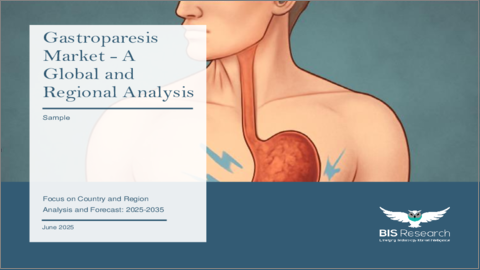|
|
市場調査レポート
商品コード
1759273
胃不全麻痺の世界市場:地域・国別の分析・予測 (2025-2035年)Gastroparesis Market - A Global and Regional Analysis: Focus on Country and Region - Analysis and Forecast, 2025-2035 |
||||||
カスタマイズ可能
|
|||||||
| 胃不全麻痺の世界市場:地域・国別の分析・予測 (2025-2035年) |
|
出版日: 2025年06月30日
発行: BIS Research
ページ情報: 英文 100 Pages
納期: 1~5営業日
|
全表示
- 概要
- 図表
- 目次
胃不全麻痺市場の主な成長要因のひとつは、1型および2型糖尿病の有病率の増加です。糖尿病は、糖尿病性胃不全麻痺の主な原因のひとつであり、これは高血糖によって胃の筋肉を制御する迷走神経が損傷されることで発症します。この神経の損傷により、胃の内容物の排出が遅れるという、胃不全麻痺の代表的な症状が現れます。 特に発展途上国での糖尿病患者の増加に伴い、糖尿病性胃不全麻痺の発症率も上昇しており、それがこの疾患の治療や管理のための需要を押し上げています。
また、血糖コントロールが不十分な糖尿病患者の増加により、吐き気、嘔吐、早期満腹感、予測困難な血糖値といった胃不全麻痺の合併症に対処するための革新的なソリューションが求められています。このような患者数の増加に加えて、胃電気刺激装置や消化管運動促進薬といった先進的な診断・治療法の開発が、市場の成長を後押ししています。
胃不全麻痺市場の成長にもかかわらず、いくつかの課題がその進展を妨げ続けています。主な課題のひとつは、早期診断の欠如や過小診断) です。胃不全麻痺は、過敏性腸症候群 (IBS) や逆流性食道炎 (GERD) など、他の消化器疾患と症状が重なることが多く、非特異的な症状として現れるため、誤診されることや、診断までに時間がかかることが多くあります。
診断自体も複雑で、胃内容排出シンチグラフィー、呼気検査、上部内視鏡検査などの専門的な検査が必要となりますが、これらの検査はすべての医療機関で利用できるわけではありません。検査の標準化がされておらず、先進的な診断機器へのアクセスも限定されているため、重症化するまで診断が遅れるケースが多く、治療が難しくなる要因となっています。
さらに、治療の選択肢も限定的です。現在使用されている消化管運動促進薬や胃電気刺激装置は、すべての患者に効果があるわけではなく、副作用のために使用が制限される場合もあります。特に糖尿病性胃不全麻痺のような背景疾患に対して、より根本的な原因に対応する治療法の開発が必要とされています。
また、長期的な管理、専門的治療、通院の繰り返しなどに伴う医療コストの高さも、患者や医療システムにとって大きな負担となっています。特にリソースが限られた地域では、これが治療へのアクセスや普及の妨げとなっており、より効果的な治療法に対する需要があるにもかかわらず、市場の成長を阻害する要因となっています。
当レポートでは、世界の胃不全麻痺の市場を調査し、主要動向、市場影響因子の分析、法規制環境、臨床試験の動向、市場規模の推移・予測、各種区分・地域/主要国別の詳細分析、競合情勢、主要企業のプロファイルなどをまとめています。
目次
エグゼクティブサマリー
第1章 世界の胃不全麻痺市場:業界展望
- 市場動向
- 規制の枠組み
- 疫学分析
- 臨床試験分析
- 市場力学
- 影響分析
- 市場促進要因
- 市場の課題
- 市場機会
第2章 世界の胃不全麻痺市場:地域別
- 北米
- 主な調査結果
- 市場力学
- 市場規模と予測
- 欧州
- 主な調査結果
- 市場力学
- 市場規模と予測
- アジア太平洋
- 主な調査結果
- 市場力学
- 市場規模と予測
第3章 世界の胃不全麻痺市場:競合情勢と企業プロファイル
- 主な戦略・展開
- M&A
- 相乗効果のある活動
- 事業拡大と資金調達
- 製品の発売と承認
- その他の活動
- 企業プロファイル
- Vanda Pharmaceuticals
- Processa Pharmaceuticals
- Neurogastrx
- CinDome Pharma
- Evoke Pharma
- AbbVie Inc.
- AstraZeneca
- Boehringer Ingelheim
- Ironwood Pharmaceuticals
第4章 調査手法
List of Figures
- Figure: Global Gastroparesis Market (by Region), $Billion, 2024 and 2035
- Figure: Global Gastroparesis Market Key Trends, Analysis
List of Tables
- Table: Global Gastroparesis Market Dynamics, Impact Analysis
- Table: Global Gastroparesis Market (by Region), $Billion, 2024-2035
Global Gastroparesis Market, Analysis and Forecast: 2025-2035
Gastroparesis is a gastrointestinal disorder characterized by delayed gastric emptying, where the stomach takes too long to empty its contents, despite the absence of any physical obstruction in the stomach or intestines. This condition is typically caused by nerve damage, particularly to the vagus nerve, which plays a critical role in controlling the stomach and intestinal muscles. When the vagus nerve is damaged, it disrupts the normal motility (movement) of the stomach, resulting in difficulty effectively emptying the stomach. Symptoms of gastroparesis include nausea, vomiting (especially after meals), bloating, early satiety, abdominal pain, loss of appetite, weight loss, heartburn, and unpredictable blood sugar levels, particularly in diabetic patients.
Common causes of the condition include diabetes, where elevated blood sugar levels damage the vagus nerve, idiopathic gastroparesis (where the cause remains unknown), and post-surgical gastroparesis following stomach or esophageal surgery. Neurological conditions like Parkinson's disease and multiple sclerosis can also lead to gastroparesis, as well as the use of certain medications such as opioids. Diagnosis typically involves gastric emptying scintigraphy, breath tests, and imaging techniques like upper endoscopy or ultrasound to rule out other potential conditions.
Treatment for gastroparesis aims to alleviate symptoms and improve gastric motility, and may include dietary modifications, medications like prokinetic agents (e.g., metoclopramide), antiemetics to control nausea, gastric electrical stimulation (GES) devices, or surgical interventions like pyloroplasty in severe cases. While gastroparesis can significantly impact a person's quality of life, proper management strategies enable most patients to control symptoms and improve their ability to eat and absorb nutrients.
One of the key drivers of the Gastroparesis market is the increasing prevalence of diabetes, particularly type 1 and type 2 diabetes. Diabetes is one of the primary causes of diabetic gastroparesis, a condition that occurs when high blood sugar levels damage the vagus nerve, which controls the muscles of the stomach. This nerve damage leads to delayed gastric emptying, a hallmark symptom of gastroparesis. As the global rates of diabetes continue to rise, particularly in developing countries, the incidence of diabetic gastroparesis increases, thereby driving the demand for effective treatments and therapies to manage the condition.
Additionally, the growing number of individuals with poorly controlled diabetes has increased the need for innovative solutions to manage the complications associated with gastroparesis, such as nausea, vomiting, early satiety, and unpredictable blood sugar levels. This growing patient population, combined with the development of advanced diagnostic tools and therapeutic options like gastric electrical stimulators and prokinetic agents, is fuelling the growth of the gastroparesis market.
Despite the growth of the Gastroparesis market, several challenges continue to hinder its progress. One of the primary challenges is the lack of early diagnosis and underdiagnosis of the condition. Gastroparesis often presents with symptoms that are non-specific and overlap with other gastrointestinal disorders, such as irritable bowel syndrome (IBS), acid reflux, or gastroesophageal reflux disease (GERD). As a result, many patients are misdiagnosed or experience delays in receiving the correct diagnosis.
The diagnostic process itself can be complex and involves specialized tests like gastric emptying scintigraphy, breath tests, and upper endoscopy, which may not always be readily available in all healthcare settings. This lack of standardization in testing and limited access to advanced diagnostics means that gastroparesis is often diagnosed only after significant symptoms develop, complicating treatment.
Additionally, the treatment landscape for gastroparesis remains somewhat limited. While there are treatments available, such as prokinetic agents and gastric electrical stimulators, these options are not always effective for all patients, and side effects can limit their use. The need for more targeted therapies that address the underlying causes of gastroparesis especially in cases like diabetic gastroparesis remains an ongoing challenge in the market.
Furthermore, high healthcare costs associated with long-term management, specialized treatments, and recurrent hospital visits place an additional burden on both healthcare systems and patients, especially in regions with limited resources. These challenges hinder the overall accessibility and adoption of existing treatments, despite the growing demand for more effective solutions.
The global Gastroparesis market is highly competitive, with several leading companies driving innovation and market growth. Companies such as Vanda Pharmaceuticals, Processa Pharmaceuticals, and Neurogastrx are at the forefront, developing novel treatments like VLY-686 (Tradipitant), PC1050, and NGX-4010 that target the underlying causes of gastric motility disorders in gastroparesis.
Other notable players, including CinDome Pharma and Evoke Pharma, are advancing treatment options with therapies like CIN-102 (deudomperidone) and Gimoti (metoclopramide nasal spray), offering more effective and convenient delivery systems for managing nausea and vomiting in gastroparesis patients.
Large pharmaceutical companies such as AbbVie, AstraZeneca, and Boehringer Ingelheim are also contributing to the market by expanding their portfolios with therapies that aim to improve gastric motility and alleviate symptoms associated with gastroparesis. With a focus on innovation, these companies are continuously pushing the boundaries of research and development to provide better treatment options, improve patient quality of life, and capture a larger share of the growing Gastroparesis market.
Market Segmentation:
Segmentation 1: by Region
- North America
- Europe
- Asia-Pacific
The global Gastroparesis market is undergoing significant transformation, fueled by several key factors that are reshaping the landscape of treatment and care. One of the primary drivers is the rising prevalence of diabetes, particularly type 1 and type 2 diabetes, which is one of the leading causes of diabetic gastroparesis. As the incidence of diabetes continues to grow worldwide, so does the demand for more effective and innovative treatments to manage the related complications, including gastroparesis. In parallel, advancements in diagnostic technologies, such as more accurate and accessible gastric emptying scintigraphy and breath tests, are enabling earlier and more accurate diagnoses, allowing for earlier intervention and better patient outcomes.
Furthermore, innovations in treatment options are contributing to market growth, with companies developing new drug formulations, gastric electrical stimulation devices, and biologic therapies designed to address the underlying causes of delayed gastric emptying. These treatments offer patients more targeted and personalized approaches, enhancing their effectiveness and minimizing side effects. As awareness about gastroparesis continues to increase, both among healthcare providers and patients, there is growing recognition of the condition as a treatable and manageable disease, further driving the demand for therapies. The combination of technological advances, increased research and development, and rising healthcare investments is propelling the market forward, positioning it for continued growth and evolution in the coming years.
Table of Contents
Executive Summary
Scope and Definition
Market/Product Definition
Inclusion and Exclusion
Key Questions Answered
Analysis and Forecast Note
1. Global Gastroparesis Market: Industry Outlook
- 1.1 Introduction
- 1.2 Market Trends
- 1.3 Regulatory Framework
- 1.4 Epidemiology Analysis
- 1.5 Clinical Trial Analysis
- 1.6 Market Dynamics
- 1.6.1 Impact Analysis
- 1.6.2 Market Drivers
- 1.6.3 Market Challenges
- 1.6.4 Market Opportunities
2. Global Gastroparesis Market (Region), ($Billion), 2023-2035
- 2.1 North America
- 2.1.1 Key Findings
- 2.1.2 Market Dynamics
- 2.1.3 Market Sizing and Forecast
- 2.1.3.1 North America Gastroparesis Market, by Country
- 2.1.3.1.1 U.S.
- 2.1.3.1 North America Gastroparesis Market, by Country
- 2.2 Europe
- 2.2.1 Key Findings
- 2.2.2 Market Dynamics
- 2.2.3 Market Sizing and Forecast
- 2.2.3.1 Europe Gastroparesis Market, by Country
- 2.2.3.1.1 Germany
- 2.2.3.1.2 U.K.
- 2.2.3.1.3 France
- 2.2.3.1.4 Italy
- 2.2.3.1 Europe Gastroparesis Market, by Country
- 2.3 Asia Pacific
- 2.3.1 Key Findings
- 2.3.2 Market Dynamics
- 2.3.3 Market Sizing and Forecast
- 2.3.3.1 Asia Pacific Gastroparesis Market, by Country
- 2.3.3.1.1 China
- 2.3.3.1.2 Japan
- 2.3.3.1 Asia Pacific Gastroparesis Market, by Country
3. Global Gastroparesis Market: Competitive Landscape and Company Profiles
- 3.1 Key Strategies and Development
- 3.1.1 Mergers and Acquisitions
- 3.1.2 Synergistic Activities
- 3.1.3 Business Expansions and Funding
- 3.1.4 Product Launches and Approvals
- 3.1.5 Other Activities
- 3.2 Company Profiles
- 3.2.1 Vanda Pharmaceuticals
- 3.2.1.1 Overview
- 3.2.1.2 Top Products / Product Portfolio
- 3.2.1.3 Top Competitors
- 3.2.1.4 Target Customers/End-Users
- 3.2.1.5 Key Personnel
- 3.2.1.6 Analyst View
- 3.2.2 Processa Pharmaceuticals
- 3.2.2.1 Overview
- 3.2.2.2 Top Products / Product Portfolio
- 3.2.2.3 Top Competitors
- 3.2.2.4 Target Customers/End-Users
- 3.2.2.5 Key Personnel
- 3.2.2.6 Analyst View
- 3.2.3 Neurogastrx
- 3.2.3.1 Overview
- 3.2.3.2 Top Products / Product Portfolio
- 3.2.3.3 Top Competitors
- 3.2.3.4 Target Customers/End-Users
- 3.2.3.5 Key Personnel
- 3.2.3.6 Analyst View
- 3.2.4 CinDome Pharma
- 3.2.4.1 Overview
- 3.2.4.2 Top Products / Product Portfolio
- 3.2.4.3 Top Competitors
- 3.2.4.4 Target Customers/End-Users
- 3.2.4.5 Key Personnel
- 3.2.4.6 Analyst View
- 3.2.5 Evoke Pharma
- 3.2.5.1 Overview
- 3.2.5.2 Top Products / Product Portfolio
- 3.2.5.3 Top Competitors
- 3.2.5.4 Target Customers/End-Users
- 3.2.5.5 Key Personnel
- 3.2.5.6 Analyst View
- 3.2.6 AbbVie Inc.
- 3.2.6.1 Overview
- 3.2.6.2 Top Products / Product Portfolio
- 3.2.6.3 Top Competitors
- 3.2.6.4 Target Customers/End-Users
- 3.2.6.5 Key Personnel
- 3.2.6.6 Analyst View
- 3.2.7 AstraZeneca
- 3.2.7.1 Overview
- 3.2.7.2 Top Products / Product Portfolio
- 3.2.7.3 Top Competitors
- 3.2.7.4 Target Customers/End-Users
- 3.2.7.5 Key Personnel
- 3.2.7.6 Analyst View
- 3.2.8 Boehringer Ingelheim
- 3.2.8.1 Overview
- 3.2.8.2 Top Products / Product Portfolio
- 3.2.8.3 Top Competitors
- 3.2.8.4 Target Customers/End-Users
- 3.2.8.5 Key Personnel
- 3.2.8.6 Analyst View
- 3.2.9 Ironwood Pharmaceuticals
- 3.2.9.1 Overview
- 3.2.9.2 Top Products / Product Portfolio
- 3.2.9.3 Top Competitors
- 3.2.9.4 Target Customers/End-Users
- 3.2.9.5 Key Personnel
- 3.2.9.6 Analyst View
- 3.2.1 Vanda Pharmaceuticals






